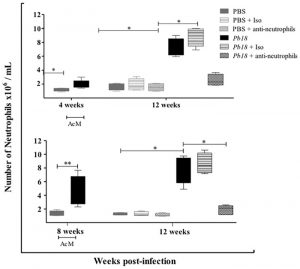BACKGROUND
Paracoccidioides brasiliensis is a human thermal dimorphic pathogenic fungus. Survival of P. brasiliensis contained in the host depends upon the difference of this fungal pathogen to completely different situations, particularly oxidative stress imposed by immune cells.
OBJECTIVE
In this examine, we evaluated the function of other oxidase (AOX), an enzyme concerned in the intracellular redox balancing, throughout host-P. brasiliensis interplay. We generated a mitotically secure P. brasiliensis AOX (PbAOX) antisense RNA (aRNA) pressure with a 70% discount in gene expression. We evaluated the relevance of PbAOX throughout interplay of conidia and yeast cells with IFN-γ activated alveolar macrophages and in a mouse mannequin of infection. Additionally, we decided the fungal cell’s viability and PbAOX in the presence of H₂O₂.
RESULTS
Interaction with IFN-γ activated alveolar macrophages induced greater ranges of PbAOX gene expression in PbWt conidia than PbWt yeast cells. PbAOX-aRNA conidia and yeast cells had decreased viability after interplay with macrophages. Moreover, in a mouse mannequin of infection, we confirmed that absence of wild-type ranges of PbAOX in P. brasiliensis outcomes in a lowered fungal burden in lungs at weeks Eight and 24 post-challenge and an elevated survival charge. In the presence of H₂O₂, we noticed that PbWt yeast cells elevated PbAOX expression and offered the next viability in comparability with PbAOX-aRNA yeast cells.
CONCLUSIONS
These information additional help the speculation that PbAOX is vital in the fungal protection in opposition to oxidative stress imposed by immune cells and is related in the virulence of P.
brasiliensis.
Bone marrow-derived mesenchymal stem cells (BMMSCs) have been take into account as a promising remedy in fibrotic ailments. Experimental fashions recommend that BMMSCs could also be used as a substitute remedy to deal with chemical- or physical-induced pulmonary fibrosis.
We investigated the anti-fibrotic potential of BMMSCs in an experimental mannequin of lung fibrosis by infection with Paracoccidioides brasiliensis.
BMMSCs have been remoted and purified from BALB/c mice utilizing standardized strategies. BALB/c male mice have been inoculated by intranasal infection of 1.5×106 P. brasiliensis yeasts.
Then, 1×106 BMMSCs have been administered intra venous at eighth week post-infection (p.i.). An extra group of mice was handled with itraconazole (ITC) two weeks earlier than BMMSCs administration. Animals have been sacrificed at 12th week p.i. Histopathological examination, fibrocytes counts, soluble collagen and fibrosis-related genes expression in lungs have been evaluated. Additionally, human fibroblasts have been handled with homogenized lung supernatants (HLS) to find out induction of collagen expression.
Histological evaluation confirmed a rise of granulomatous inflammatory areas in BMMSCs-treated mice. A big improve of fibrocytes depend, soluble collagen and collagen-3α1, TGF-β3, MMP-Eight and MMP-15 genes expression have been additionally noticed in these mice.

Interestingly, when mixed remedy BMMSCs/ITC was used there’s a lower of TIMP-1 and MMP-13 gene expression in contaminated mice. Finally, human fibroblasts stimulated with HLS from contaminated and BMMSCs-transplanted mice confirmed the next expression of collagen I. In conclusion, our findings point out that late infusion of BMMSCs into mice contaminated with P. brasiliensis doesn’t have any anti-fibrotic impact; probably as a result of their interplay with the fungus promotes collagen expression and tissue reworking.

